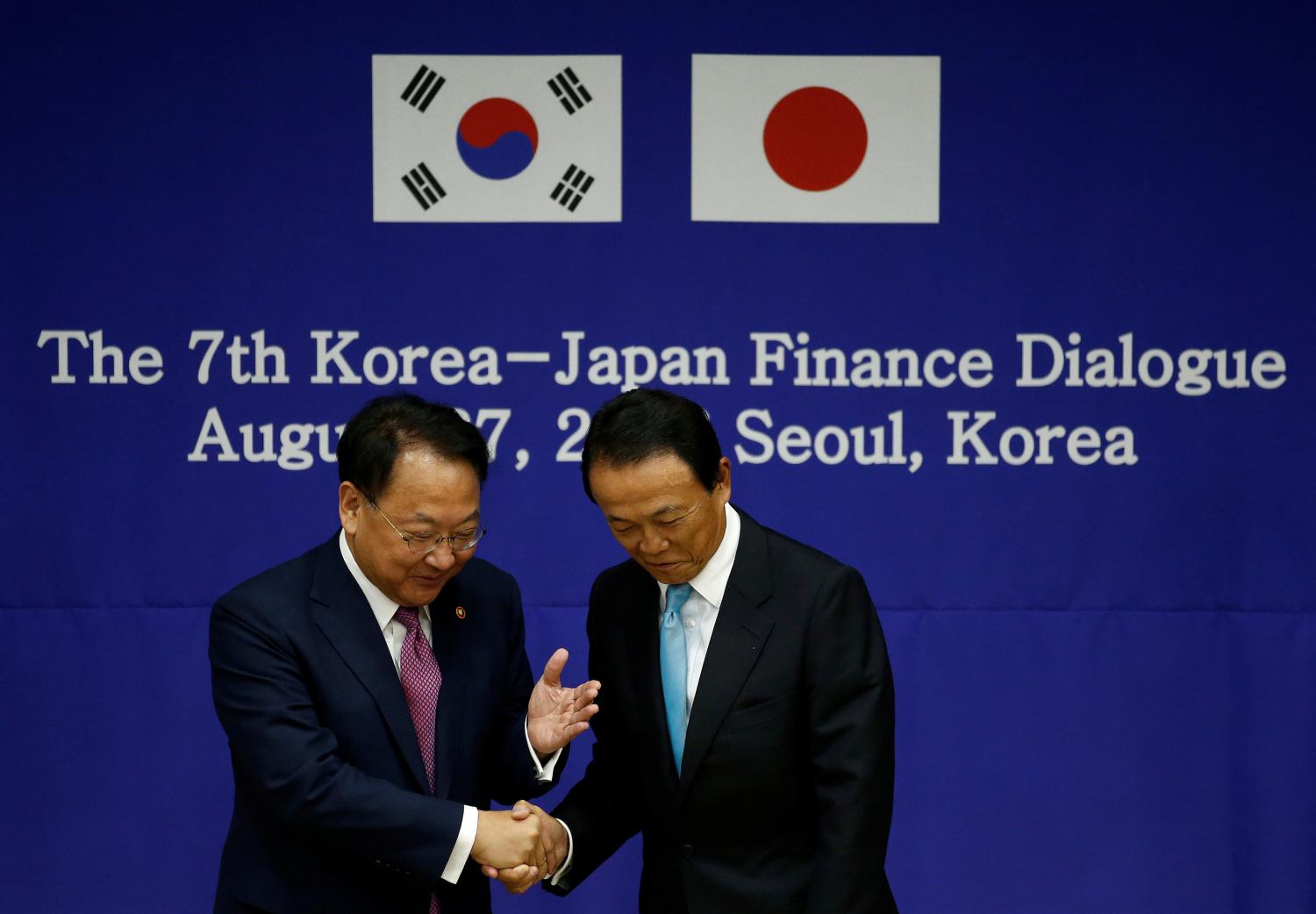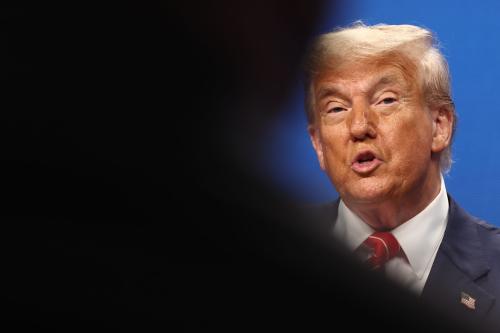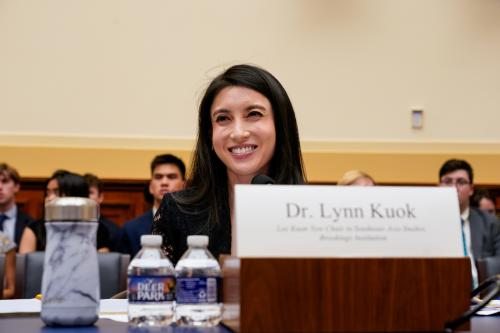Without question, the best hope to boost business opportunities and economic growth world wide would be the successful completion of the Doha Development Round. But the global trade talks are floundering and only modest results are now hoped for. In this environment, is it important that the United States take out some insurance coverage? You bet. Proceeding with a proposal to launch a Free Trade Area of the Asia-Pacific (FTAAP) might be just the right insurance policy, and the APEC summit in Sydney in early September provides an opportunity for progress on this initiative.
Now is the time for the United States to shore up its standing as a country open for business. We must be rigorous in passing recently completed free trade agreements (FTAs) and must pass new fast-track legislation giving the president authority to negotiate trade deals. We must also find ways to foster trade liberalization in the fastest growing region of the world: Asia.
During the past decade, the expansion and integration of Asian economies has continued to march forward. China, Japan, and Korea are engaged in various trade negotiations with the 10-country Association of Southeast Asian Nations (ASEAN). Asia currently has some 60 FTAs in force with another 117 under negotiation.
However, some of these FTAs include carve-outs for politically sensitive sectors such as agriculture and services, and establish a hodge-podge of standards governing intellectual property, competition policy, and rules of origin. Many of them do not meet the requirements of the World Trade Organization (WTO) and do not hold to the high standards that the United States imposes in its bilateral agreements.
So what is the United States going to do about the proliferation of trade agreements in Asia? Should we sit on the sidelines? Of course not!
There is only one conclusion in my view. The United States should take steps to ensure that we participate in initiatives that would further open and develop the rapidly expanding Asia market for American business. We should continue to pursue FTAs such as the U.S.-Korea trade deal that are comprehensive, ambitious and complement the Doha Round by promoting high standards in important areas like services, competition policy, and intellectual property. But that alone may not be enough.
That is why I believe that when the leaders of the 21-member Asia Pacific Economic Cooperation (APEC) forum sit down for their annual summit in Sydney in early September, the United States should call for increased effort to launch the FTAAP. At their summit in Vietnam last November, the leaders, encouraged by U.S. President George W. Bush, agreed to call on their officials to undertake feasibility studies about creating an APEC-wide free trade zone. The fact that no regional government blocked the proposal is a good sign and shows that there is interest even if significant political and technical obstacles remain.
An FTAAP could potentially create the largest trade liberalization agreement in history. APEC member countries control half of world trade and account for 60% of the global economy. They are home to nearly 3 billion consumers in some of the planet’s most vibrant economies.
The FTAAP would ensure an ongoing role for U.S. companies in the region’s dynamic growth at a time when governments in the Asia-Pacific are negotiating a raft of preferential trade agreements that exclude the United States. If instead of making progress on an FTAAP, for instance, China, Japan, and Korea all forge preferential agreements with ASEAN, this will affect U.S. political and economic interests negatively. Exclusion from a potential East Asian Free Trade Area involving China, Japan, Korea, and Southeast Asia could cost American companies $25 billion a year in exports.1
Even for Japan, China and Korea, there are clear benefits of reaching a broader FTAAP over more exclusive bilateral or regional FTA arrangements. For example, as measured in one study, China’s “economic welfare” benefit from an FTAAP would be six times larger than from a regional FTA with ASEAN, Japan, and Korea.2 The same study noted that Japan’s benefit would be more than twice as high from an APEC-wide pact than from one with only China, Korea, and Southeast Asia.
Moreover, an FTTAP provides a vehicle through which countries in the APEC region would move individually and collectively toward greater economic integration and reform. To comply with WTO rules, the FTAAP would have to eliminate barriers on “substantially all” trade in goods and the liberalization of trade in services would need to provide “substantial sectoral coverage.” It also would need to liberalize investment regulations among the APEC economies and adopt provisions in such areas as rules of origin, standards, customs procedures, and intellectual property rights protection.
The economic benefits could be enormous. While difficult to project, one economist has estimated in a recent study that 18 of the 21 APEC economies would see an estimated “economic welfare” benefit from an FTAAP of over $44 billion.3
Is the FTAAP a negative distraction to the Doha Round? I think not.
Indeed, even modest progress in launching talks on an FTAAP might serve as a catalyst to inject new energy into the stalled Doha negotiations. The prospect of a new APEC liberalization initiative would force non-APEC economies to recognize the risk they face of being left out of economic integration efforts beyond of their influence. It might serve as a wake-up call for the European Union, Brazil, India, and others to start removing barriers to progress in the Doha negotiations.
Like C. Fred Bergsten, director of the Peter G. Peterson Institute for International Economics, I believe that just having discussions on the merits of an FTAAP has injected some needed life back into APEC at a time when many are questioning whether the institution has outlived its usefulness as a trade liberalization forum. APEC has made little progress in reaching the goals for trade liberalization the leaders set at their 1994 summit in Bogor, Indonesia. For many business leaders it has become little more than a talk shop. Launching an FTAAP, with the right framework, could do much to bolster the institution as well as promote regional cooperation on trade expansion.
Many have described the dozens of bilateral and regional preferential trade liberalization efforts in the Asia-Pacific with different rules and standards as having created a “spaghetti bowl” effect. I do not disagree. Indeed, APEC economies would benefit if they simply agreed to work together to harmonize the conflicting rules that exist under already completed trade arrangements. This ought to be one of the agreed upon goals sought in an FTAAP.
Despite the potential benefits from an FTAAP, giant obstacles need to be overcome before negotiations can begin in earnest. APEC leaders meeting in Vietnam last year called the FTAAP “a long term prospect.” When U.S. officials estimate that an agreement could take up to 15 years to hammer out, it doesn’t inspire confidence or enthusiasm from business leaders.
Key challenges exist. First, an FTAAP would require a modification of APEC’s longstanding mandate that it is an institution in which decisions are voluntary and non-binding. The grouping was set up in 1989 to build a regional economic community, not to negotiate trade agreements. Cobbling together an FTAAP would require binding agreements rather than the informal, voluntary commitments of the past.
Second, it would require a strong commitment from the region’s major economies, particularly China, Japan, Korea, and the United States, to drive the negotiations. This is not an easy task given that each of these countries has internal dynamics that could raise political challenges against promoting an FTAAP.
While China would gain from enhanced liberalization that allowed its companies to penetrate foreign markets with its cost-competitive manufactured goods, Beijing is presently lukewarm to an FTAAP. China might want to retain investment barriers in services such as banking, telecommunications, and transport. It might also be reluctant to be drawn into negotiations including Taiwan.
Japan also could be a huge economic beneficiary of a regional trade agreement. Yet, Japanese government leaders face significant opposition from powerful agricultural and service interests whenever FTAs are proposed. Overcoming stiff domestic opposition, including from rice farmers, would not be without political costs to the government. Agriculture will also be a “sticky” issue for the United States and a number of Southeast Asian countries.
Ultimately, domestic support for farmers in the Asia-Pacific and subsidies for the region’s exporters could be as difficult to tackle in an FTAAP as it is the Doha negotiations. This has prompted some to conclude that it might be best to resolve these issues in the Doha Round before resorting to regional pacts. Others believe it will only be feasible to negotiate an FTAAP if leaders agree upfront to exclude certain sectors from the negotiations.
Finally, the United States also faces immense challenges given the current political environment in Washington. Even in the best of times, a trade negotiation of this size and one that includes China would not be easy. Protectionist sentiment is running high and is fueled by a growing public perception of a weak U.S. economy and anxiety about a growing trade deficit with China. Congress is in no mood to give its blessing for the administration to plow ahead in FTA negotiations with China, even if other economies are at the table.
In reality, the FTAAP might actually offer hope for resolving some of the underlying tensions in the U.S.-China commercial relationship. It would take significant bilateral irritants and place them into a regional, non-threatening forum and might foster greater collaboration from China, particularly if it recognized economic benefits for participating at the negotiating table. FTAAP talks should not replace existing U.S. efforts to negotiate some of its core trade differences with China bilaterally, but it might provide additional tools and be seen by the Chinese as less confrontational.
Despite these significant hurdles, I would encourage APEC leaders to enhance their efforts with regard to the FTAAP. President Bush neither needs fast track authority to agree to support a comprehensive review of the potential of an FTAAP nor does he need this authority to support, at an appropriate time, the launching of such talks. He does, however, have an obligation to explain to Congress and the general public how such an initiative would advance U.S. strategic political and economic interests in the Asia-Pacific.
With presidential elections taking place in little over a year, it would be easy for the United States to slide backwards and retreat from global economic engagement. This would be a big mistake. We need to continue to find ways to advance our economic interests in multilateral, regional, and bilateral forums. We should pursue progress in the Doha Round and ratify completed FTAs such as the one with Korea. And we should look for ways to lock in more reform and openness in the Asia-Pacific through creative initiatives like the FTAAP.
The economic significance of an FTAAP, concluded under the right terms, would dwarf that of all other economic arrangements. Every once in a while a big idea emerges that is worth consideration and engagement. This is one of those ideas. It is an idea that America and the other APEC economies should engage.
The Brookings Institution is committed to quality, independence, and impact.
We are supported by a diverse array of funders. In line with our values and policies, each Brookings publication represents the sole views of its author(s).




Commentary
Op-edA Free Trade Area of the Asia-Pacific: An Idea with Merit, but Is It Feasible?
September 1, 2007